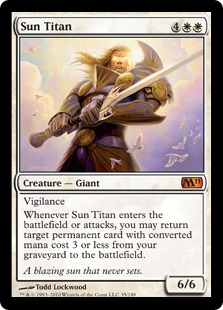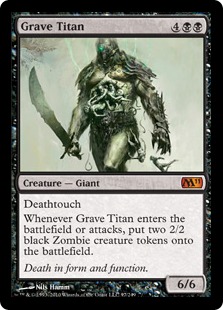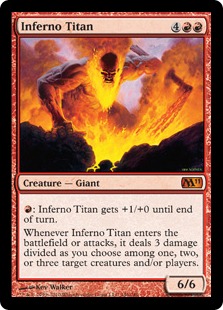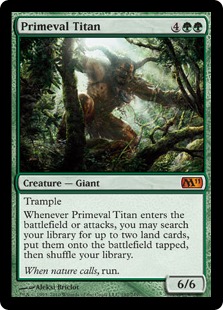Hello! I’m glad to introduce you to the first article of my own biweekly column. Yep, I’m the guy who won the whole shebang, err… meaning the
StarCityGames.com Talent Search Contest. For that, I want to thank so many people, but business comes first, so all the props will be waiting for you
in the postscript, while we get to work!
Today, I’m going to write about the five Titans and reasons for them to fade in and out of popularity. Most importantly, we’ll have our own little
contest here and decide which Titan is the best to play right now. And, surely, you’ll be treated with the hottest Caw-Blade mirror tech, so stay tuned
till the very end of the article!
Aside about column name
As you can see, the name of my column is “Behind the Curtain.” I think it perfectly reflects how I see my role as a SCG writer: I want to look into the
hidden mechanics of the game and prepare my readers (and myself, too) for starring in plays as interesting as Shakespeare’s — Magic tournaments. So, if
we want to step over the edge separating auditorium and scene, we want to go Behind the Curtain and learn our part first.
End aside
Ever since the release of M11, the five Titans have been true powerhouses of Standard, but there was no single moment when all five of them were good
all at once. The Titans’ game-breaking potential is very close to that of planeswalkers. Why? Not only do they affect the board nanoseconds upon
resolving, they continue to dictate the game state every turn after that, producing an incredible amount of advantage if left unanswered. Yet nothing
can stay unanswered, so the history of the Titans in Standard is an epic tale, full of wins and losses, feats and betrayals, courage and stupidity… Oh,
okay.
The First Era: Titans versus Elves and their Lizards
…There was a world for the young Titans to emerge. The world was cruel and fearsome. Even Elves abandoned beauty and charm in favor of blood and
blight… Titans came to purge the world, and even volcanoes helped them in their battle. The Great War has started…
Right prior to the release of M11, the metagame was all about Jund and the ways to beat Jund. U/W Control, Mythic Conscription, Next Level Bant, Boss
Naya — the list of Jund-killer wannabes was endless, and it became much longer with new set — Fauna Shaman, Destructive Force, and Titans had instantly
created a number of various decks, powerful enough to compete with the cascade-fueled menace. Let’s not forget that it was summertime, meaning
Nationals were swinging all around the globe, and those were the first major tournaments for the Titans to appear… After looking at Top 8 lists from
nine large Nationals, we see the following quantities of the Titans:
Primeval — 58
Sun — 21
Grave, Frost, and Inferno combined — 9
Taking into account the fact that Primeval Titan was mostly used as a four-of while there were 1-2 Sun Titans in U/W Control, we can clearly see that
these two were the best Titans at that time.
Primeval Titan had created a few archetypes on its own, with a little help from Zendikar/Rise lands (Valakut and Eldrazi lands), as well as from
Destructive Force and Knight of the Reliquary. He had two big things going for him. First, his decks were fast enough to outrace Jund and combo decks
like Polymorph or Pyromancer Ascension. Second, his decks were abusing a common weak spot of Alara-Zendikar decks — the multicolor mana base. After
resolving Destructive Force with any Titan in play, it was hard to lose.
The other beloved Titan, Sun Titan, was good simply because he perfectly fitted in an established and powerful archetype, U/W Control, giving it an
important card-advantage tool. It pushed Wall of Omens (which was very powerful in the world of Bloodbraid Elf and Sprouting Thrinax), Jace Beleren (do
you really want to win Jace wars?), and Tectonic Edge over the top.
So, what about the three other Titans? Why were they left on a bench? Inferno Titan had no good targets (Sprouting Thrinax laughs at you, poor Arc
Lightning); Grave Titan wasn’t really suited for Jund and had no other deck to shine in. Frost… I think that Frost Titan was criminally underestimated
and misunderstood at the time. Yet he had his last laugh after Bloodbraid Elf rotated out of Standard.
The Second Era: Titans versus Demons
Over the centuries, mankind has tried many ways of combating the forces of evil… prayer, fasting, good works and so on. Up until Doom, no one
seemed to have thought about the double-barrel shotgun. Eat leaden death, demon.                      Terry Pratchett
Coming into the fresh waters of Zendikar-Scars Standard, it was clear that Valakut was the most powerful deck around, so Primeval Titan was bound to
remain the best one, despite the fact that the number of archetypes he supported shrunk to two — namely, Valakut Ramp and Mono-Green Eldrazi Ramp.
There were many attempts to beat Primeval Titan, so the two months separating the Scars release from Worlds in Chiba saw the metagame completely
warping back and forth many times.
By the time Worlds rolled in, the Magic hive mind had realized that a combination of hand disruption and countermagic presented the most solid angle of
attack against Valakut, and U/B Control became a default choice for control-minded players. And since the main target was Valakut, Frost Titan became
the default finisher. It was only at this moment people came to understand the true power of Frost Titan: not only did it hamper Valakut’s main plan,
disrupting its mana development, it shut down the big green menace itself. And, conveniently enough, it requires significant mana payment to ever
attempt to kill it with Valakut triggers.
Frost Titan was the main reason why U/R Control was Gerry T’s beloved pet for some time in October and November. Let me quote one of his articles from
that era:
“Initially, I had Inferno Titans instead of
their Frosty compadres, but I cannot stress how much betterFrost Titan is. While Inferno Titan is going to crush decks based on
weenie creatures, the rest of the deck should do that for you. Frost Titan beats every other Titan in a fight,
which is incredibly important with the recent success of the ramp decks.”
However, another shift was on the horizon. As U/B was gaining popularity, Frost Titan was looking weaker and weaker. He just wasn’t a reliable finisher
anymore. The reason for this was? The default removal suite of U/B: Doom Blade quickly became the prime kill spell of the format, and Frosty was
extremely vulnerable to it. Even the “pay two” clause couldn’t fool anyone: two mana is not big enough of an obstacle when dealing with an opposing
finisher, especially in control mirrors where there are only so many threats you should deal with. So, the crowd rushed to find a replacement.
The solution was found quickly, and it was truly demonic in its ingenuity: Abyssal Persecutor. It solved the Doom Blade problem by being black and the
Valakut problem by being a full two turns faster than Frosty. In fact, the speed boost provided by Persecutor was so impressive that some versions even
incorporated Everflowing Chalice to speed the clock up for another full turn. The idea behind this was trivial: the less turns it takes to kill the
opponent, the less counterspells you’ll need to stay in the game. Persecutor fit this role nicely.
Another quote from Gerry T:
“Abyssal Persecutor was the first step in
the right direction. The U/B mirror hinged mostly on sticking a threat and then protecting it. It was very rare that sneaking in a Jace produced a
victory because of opposing Creeping Tar Pits
and Jaces.”
However, U/B players quickly realized that it was more profitable to fight over ways to remove Persecutor from the battlefield than to fight over the
Persecutor itself. Additionally, removing Persecutor from the battlefield could be a serious liability, especially under pressure from aggressive
decks, thus the popularity of Abyssal Persecutor slowly faded away, only to give way to yet another Titan…
The Third Era: Titans versus Titans
“There is always a greater power”
Flavor text of Cruel Ultimatum
Grave Titan entered the scene as unexpectedly as ever. There were five U/B Control decks and only one Primeval Titan deck in the Top 8 of Worlds. It
was not a “fair” result per se (because of Draft and Extended portions of the event mixing up results), but you know, Top 8 is the only thing that
people care about. To be honest, there were seven Grave Titan decks and fourteen Primeval Titan decks among best Standard records. Primeval Titan
continued to be the best one, but Grave Titan, thanks to a Guillaume mirror in the final of the Worlds, pursued his green brother while gaining much
more publicity.
The rise of Grave Titan was made possible by numerous factors. Resistance to Doom Blade was one of them, but it was only a part of the big picture: in
the U/B mirror match, most decks had zero ways to deal with a resolved Grave Titan, or at least no way to break even. The closest to a “good answer”
was Consuming Vapors but only in combination with a Ratchet Bomb or a Consume the Meek to cleanse the table from Zombie minions. Any other spell just
fell flat because it took only two swings from an unopposed Grave Titan to finish the game.
It was also interesting that Grave Titan emerged right after the aggressive decks started to utilize Mark of Mutiny against both Valakut and Persecutor
U/B: Mark of Mutiny still left your opponent with two Zombies to harass you with, but at least you could block the traitor with your own Zombies — and
Persecutor pilots didn’t have that luxury (and poor Primeval Titan pilots are still getting nightmares from getting hit for eleven with their own
Titans after they fetch up double Teetering Peaks).
At that point, Standard entered equilibrium because Extended PTQs were the only thing of interest. The new king was born unnoticed (do not forget that
Brian Kibler made 6-0 with Caw-Go at the first day of Worlds), and nobody really cared — everybody waited for the storm in Paris. And the Storm came…
The Fourth Era: Titans versus Hawks
…and it was spoken that the one who shall draw Excalibur from the stone would be able to defeat the titans and to become a king.
With the printing of Sword of Feast and Famine, another new era had started. Sword-equipped Squadron Hawks became the most powerful creatures in
Standard, beating both Primeval Titan and Grave Titan. Still, Valakut was seen as a good choice despite its failure to appear in the Top 8 of Worlds.
But then PT Paris came and went, and surprisingly there were no Primeval Titans in this Top 8 either. Finally, a sign that Primeval Titan decks had
become poorly positioned. And so, after half a year of harassing the Standard format, Primeval Titan was tamed. Surely, ye surely will return, but
nobody knows when. My guess is his revenge will come when Hawks concentrate too hard on defeating each other or when Wizards print Avalon instead of
Valakut.
But which Titan deserves to take the crown now?
Let’s look again at the very same quote from Gerry T’s article:
“…Inferno Titan is going to crush decks based on
weenie creatures…”
Did something really change since those words were written? Not much. Except the fact that decks based on weenie creatures are dominating Standard now.
Inferno Titan kills every unequipped creature in Caw-Blade and even kills an equipped Hawk, and he keeps doing it every turn! Do I have to mention that
an early Inferno Titan just slaughters Boros and Vampires? All these facts considered, it’s clear that Inferno Titan is the most powerful threat
against Caw-Blade and, potentially, the best Titan right now. You can see the singleton Inferno Titan as a tech for the mirror in AJ Sacher list from SCG Open: Edison, so why don’t you just
play 2-3 Inferno Titans maindeck to beat these ugly Hawks?
Everything you need is to land your Titan early enough to prevent Caw-Go from taking advantage using equipped creatures. There are two ways to land
Inferno Titan fast: Lotus Cobra (read: RUG Ramp) and Valakut Ramp. But Spell Pierce is a big problem for Valakut because it counters all the
non-creature acceleration, so we have two ways to deal with it: wait until they stop playing Spell Pierce or… stop playing noncreature acceleration and
make their Spell Pierces useless.
Here is a deck used by a fellow Russian player Basil Sasorov (one of the most prominent Russian deckbuilders, with some Nationals Top 8s under his
belt) to qualify for Russian Nationals:
Creatures (21)
- 2 Acidic Slime
- 4 Lotus Cobra
- 3 Oracle of Mul Daya
- 1 Nest Invader
- 3 Overgrown Battlement
- 3 Inferno Titan
- 1 Obstinate Baloth
- 4 Primeval Titan
Planeswalkers (2)
Lands (26)
Spells (11)
Sideboard

First of all: “3 Valakut” is not a typo. This deck is not exactly a “Valakut deck.” It’s more like an R/G Ramp with a large variety of win conditions,
with Inferno Titan being the most important one, and Valakut as just one among the others. The main goal of the deck is to beat Caw-Go and random aggro
stuff (an important task to accomplish in an unfamiliar and unshaped metagame). The second goal of the deck is to use Green Sun’s Zenith as optimally
as possible. The list is quite rough (despite being successful at least once), so I’ll provide some guidelines to tuning the deck instead of saying “go
sleeve this 75 and play.”
The deck ramps more slowly than common Valakut builds (read: it loses to Valakut, if you’re suddenly worried), but it isn’t afraid of Spell Pierce
(fair trade, for my liking). A bunch of removal spells help us to survive any early aggression until we’re able to start casting big threats. Note that
Arc Trail is as good as Pyroclasm most of the time, if not better (doesn’t kill your own Cobra).
By the way, I seriously consider leaving Cobra in the deck post-board even against aggressive decks because all we really want to do in such matchups
is to land Inferno Titan as early as possible. Sure, Cobra dies to removal, but who doesn’t?
Another option I want to touch on is Cunning Sparkmage, as he could be superior to Pyroclasm in the sideboard. He could also take care of opponent’s
Cobras and even Overgrown Battlement (with a little help from Lightning Bolt) and help us to gain an upper hand in the “mirror.”
Another idea for the faux-mirror is a singleton Tectonic Edge replacing a Mountain. For stock Valakut lists, ten Mountains is too few, but this deck
rarely kills with Valakut, and our Primeval Titan often searches up Raging Ravine anyway, so I don’t see any arguments against trying to be cute with
Tectonic Edge.
Green Sun’s Zenith’s (don’t forget playing around Spell Pierce; they have no other targets!) toolbox contains Acidic Slime, Obstinate Baloth, and Nest
Invader (instead of a fourth Overgrown Battlement, because you don’t really like to draw two of those in this deck, and sometimes all you need are two
blockers produced by a single card). An additional sideboard option is Gaea’s Revenge — but, sincerely, it’s the weakest card in the deck, so feel free
to cut it if you want.
Other possible targets for Zenith are:
1)Â Â Vengevine — nobody cares about resurrecting; he’s just a cheap green creature with haste to kill a planeswalker out of nowhere. Vengevine is like
Koth that could be found by GSZ.
2)Â Â Viridian Corrupter — searchable Shatter, cheaper than Acidic Slime and a good blocker against Boros.
3)Â Â Thrun, the Last Troll. Day of Judgment is a serious problem, as it kills all our acceleration, so maybe Troll is a guy to lean on. And, if we plan
to destroy their sword, Thrun becomes a serious threat. He’s not outstanding, but he could fill a specific role in this deck.
So, that covers the basics of the deck. Feel free to try it if you want to beat Caw-Blade while playing the best Titan in the format. Inferno Titan is
surely able to give fire to the people, but unlike poor Prometheus, he is able to prevent Zeus’s
eagles
hawks from eating his liver!
The Fifth Era: Future of the Titans
Time will help you through
But it doesn’t have the time
To give you all the answers
to the never-ending why
Placebo, “The Never-Ending Why”
So, what about the second-best Titan? Would I give this title to Sun Titan? He’s still good in U/W Control. He’s able to resurrect your Sword of Feast
and Famine, Squadron Hawk, or Tectonic Edge, which should be enough to break the mirror match wide open — all you want is an endless stream of equipped
birds. Hmmm… Did I just say “endless stream of birds?” Please, welcome our tech of the week: Emeria Angel! Her birdies are white, conveniently helping
you block opposing sword-wielders. Moreover, Emeria birds can carry swords themselves, too, and, most importantly, recent Caw-Blade lists splashing red
run up to nine fetchlands, pushing Emeria Angel directly to “mirror superstar” status! She is two mana cheaper than Sun Titan (read: easier to resolve,
easier to protect), and she makes Mortarpod insane (my team’s Paranoid Data Miner will surely slice my throat for letting the secret out, but such is
the life of a common strategy writer — everything for the readers).
Will there be a time when Titans go away and leave the world to birds or other lesser critters to rule unharassed? I’d say “no.” Birds and angels are
good, but Titans are too powerful to stay behind the curtain. It’s really interesting to imagine which Titan will be the best one after Valakut rotates
out, leaving Primeval Titan without his favorite toy, but for the time being, I predict Inferno Titan being a house and Sun Titan growing in popularity
— and with that, the circle will close, and the roundabout of Titans will start anew. Happy riding!
Am I right? Time will tell, but for the time being, I’ll try to prove that Inferno Titan is still the best one. My next submission will come from
Barcelona, Spain, where I expect to play the largest Standard Grand Prix ever.
Feel free to ask anything you want and see you next time! And if any of my readers plan to attend Grand Prix Barcelona, I’d be delighted to meet them
in person.
Valeriy Shunkov
@amartology
on Twitter
amarto in MTGO
valeriyDOTshunkovATgmailDOTcom
P.S. As promised, some props I owe to all the good people for helping me win the SCG Talent Search:
SCG crew and especially Ted Knutson: for the great opportunity.
Patrick Chapin: for mentoring. Your advice was brilliant and helped me tremendously. I really mean it. By reading your articles, I’ve become a better
player already; by being mentored by you, I’ve become a better writer.
Alex, Basil, Bogdan, Nikita, and Victor: for help and inspiration.
Mary: for coming up with the “Behind the Curtain” name.
Russian Magic community: once again, your great support and cheering were second to none.
Dan Barrett, Jeremy Froggatt, Tom Reeve, and John Beety: for our little rivalry that became a true source of inspiration for me; oh, and let’s not
forget all the awesome Twitter conversations. I’m really thankful for them too.
All readers: for your support, your faith, and your votes during the contest. I hope I’ll exceed your expectations!





